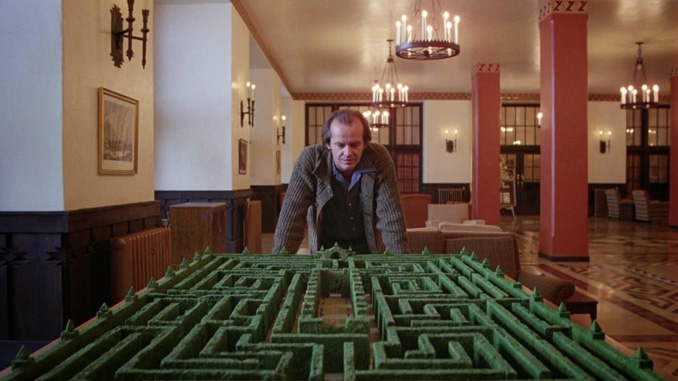
I begin my list of Truly Terrifying movies with Stanley Kubrick’s much-loved, much-loathed 1980 film, The Shining, simply because its weaving together of creepy-as-fuck modernist music with claustrophobic, low-angle camera work and the classic tropes of all those old Gothic novels makes it one of the most ambitious horror films ever produced.
Anyone who’s experienced 2001: A Space Odyssey knows that Kubrick gets off on ambiguity. He likes to leave you confused and unsettled. He wants to pull the rug — and sometimes the whole damn planet — out from under your feet. I mean, what the fuck’s up with the giant floating world-baby at the end of 2001, anyway? For that matter, what sense can we find in the fight scene in the war room near the conclusion of Dr. Strangelove?
Simply put, Stanley Kubrick doesn’t offer us a cinema that affirms our grandest hopes or answers our most bewildering questions. His cinema revels in uncertainty and irony. It taunts us with questions that it never intends to answer. Kubrick’s not a world builder, not a myth maker. He’s not a Peter Jackson or a Stephen Spielberg, not a Cecil B. DeMille or a George Lucas. He’s a deconstructor, an artist more interested in demythologizing than in myth-making. His peers are directors like Billy Wilder and Alfred Hitchcock on one side of film history, David Lynch and Charlie Kaufman on the other.
That’s why most of the people interviewed in Room 237 — Rodney Ascher’s fun-as-hell 2012 documentary about fans of The Shining — seem to be missing the point of Kubrick’s film, entirely. In seeking to answer questions about The Shining and to resolve its many indecipherable codes, the Kubrickophiles want to proclaim The Shining a masterpiece at the same time that they strive to comprehend it, to render the movie’s enigmas and puzzles intelligible.
Look, I get it. I mean, when something freaks your ass out, you want to understand it, right? If you have a nagging pain in your gut, you go to the doctor so you can figure out what’s causing the pain. A smart person wants to use reason (and medicine) to fight off disease and discomfort. Understanding and knowledge provide us with the tools to fight fear.
The Shining allows us no such tools, no such comforts. The film’s enigmas remain, for lack of a better word, enigmatic. If you go to movies seeking enlightenment, wisdom, or solutions, Kubrick just isn’t the filmmaker for you. Perhaps what Pauline Kael said about him all those years ago in the New Yorker ends up being right after all: Kubrick’s a brutalist, a sadist. That’s to say that if you value reason or hope or your own mental health, watch a Pixar film. If you want to get fucked up, watch The Shining.
But, OK, OK. I hear you. I’ll stop talking about the legend of Stanley Kubrick and the classic status of his one and only foray into straight-up horror filmmaking and start talking about the film itself.
Moving back and forth between a descent-into-madness fable and a haunted house story, The Shining — based fairly loosely on the 1977 novel by Stephen King — tells the tale of the Torrance family. Jack (Jack Nicholson), a would-be-novelist and the Torrance patriarch, takes a job as the caretaker of the Overlook Hotel — a tremendous, ornate, labyrinthine ski lodge in the Colorado Rockies.
And BTW, a caretaker from years back chopped up his wife and twin daughters with an axe before committing suicide in the hotel — because of-fucking-course he did.

It seems that the Overlook has to close during the snowiest months of the year because the roads leading to it become impassable, and Jack believes that by taking on the job of winter caretaker, he’ll find the peace and quiet he needs to work on his novel.
Oh, the hotel might just be haunted as fuck, so Jack brings his wife Wendy (Shelley Duvall) and his six-year-old son Danny (Danny Lloyd) along, too. Why do Wendy and Danny agree to this winter-long sojourn with the old man in the spooky hotel? They don’t have any choice. This is 1980. It’s the last days of the single-income, middle class family. Jack’s the breadwinner, and any good family has to follow the lead of breadwinner, right? So, the tiny Torrance clan heads out to the thoroughly isolated, overly large Overlook. What could go wrong?
Well, what follows is as visceral and epic a dismantling of the nuclear family and of the father’s role as guardian and provider as you’ll ever find in a big-budget film.
Now, The Shining features one of Nicholson’s most legendarily over-the-top performances, and when you realize that we’re talking about the guy who brought characters like R.P. McMurphy, Jake Gittes, and the Joker to the big screen, that’s really saying something. I mean, Nicholson played the demon with the twisted dong who sleeps with Michelle Pfeiffer, Susan Sarandon, AND Cher in The Witches of Eastwick, but when film fans picture him, it’s almost always with his face crammed into that broken, yellow door and his eerie voice howling, “Here’s Johnny!” Sure, Jack’s dizzying highs and bottomless lows imitate the classic patterns of the type of man who abuses his wife and child, but in a sense, the performance remains more grotesque than nuanced, more caricature than real.
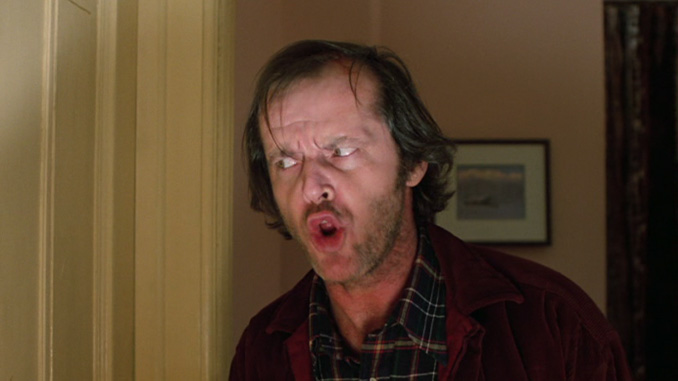
Precisely by being so outrageous, Nicholson’s acting provides us with a devilish dilemma. As much as we want to flee or hate abusers like Jack Torrance, we find old Jack’s performance to be eerily, uncannily, freakishly alluring, like some bizarre Salvador Dali-style parody of a father. It’s hard to look away as he melts and mutates onscreen.
Like Peter Sellers playing the title character in Dr. Strangelove, Nicholson as Torrance increases the creep-factor of the entire film precisely by overplaying his role. Why would you possibly want to see a Nazi scientist come up with a masturbatory plan for preserving male privilege in a bombed-out, post-apocalyptic world? Why would you want to watch an insane father try to hack his family to pieces? You wouldn’t (I hope). But if you give that same sinister character an over-the-top parodic spin, if you give him charisma and dynamism and a cynical panache, viewers will probably begin to enjoy him despite their own better judgement.
Kubrick began his career as a photographer, and every frame of The Shining works like some grand, glorious painting. You could lose hours gazing into even a single sequence of the movie. The breathtaking opening shots move over mountains and roads and rivers while simple resting shots of young Danny playing on the floor of the Overlook are complicated by the intricate, angular patterns on the carpet.
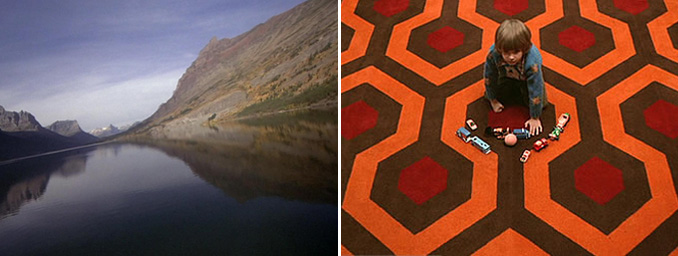
As a result, we get a film that constantly switches scale on us, a film that moves from the large and sublime to the minute and refined. The result is overwhelming, and on a first viewing it’s hard to know which images require close inspection and which can be passed over without much reflection.
In fact, for a film that offers us any number of ponderously long, moody sections without dialogue, The Shining always commands its viewer’s full attention, always requires an alert, intense gaze.
But why do I find The Shining truly terrifying? Yes, it’s frightening because of its imagery (creepy ghost twins, rivers of blood flowing through hallways, decaying nude bodies rising from bathtubs). And sure, Kubrick’s also very good at the slow-boil, at making us crave something that he only intends give us in his own sweet time.
But the most unsettling thing about The Shining remains the uncertainty it provokes in the viewer. The film’s conclusion refuses to give us any real answers. I mean, is the Overlook some kind of conscious entity? Was Jack really going mad during the movie, or has he been bug-fuck crazy the whole time? BTW, how the hell did Jack end up in the photo, taken in 1921, that provides us with the film’s closing shot? AND what in the actual fuck is up with the chipmunk dude going down on the guy in the tux?
Most horror films — even when they end in terrifying or tragic ways — offer us clear answers or a clear way out. These narratives move us from scared to content, from naive to informed. The Shining refuses this kind of movement, entirely. It gives us what Kubrick almost always offered the cinema-going public: moral and epistemological uncertainty. It brings up questions that no one (not even an artist/creator) can really answer.
Horror seems more frightening to me when its beasts and mysteries remain obscured by vague, hazy shadows. When a horror film reveals its monsters or solves its puzzles in the clear light of day, it’s no longer very scary. By denying us both an understanding of what animates and drives the ghostly terrors of the Overlook Hotel and any real solutions to the film’s many riddles, The Shining resides in the shadows, in the darkest places of the human imagination, in the realm of uncertainty. For my money, that’s where all good horror films should remain.

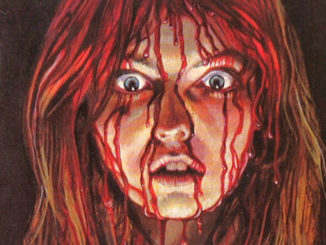
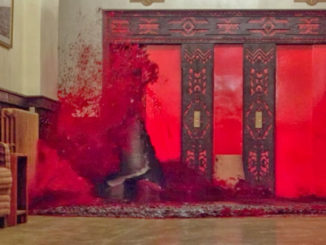
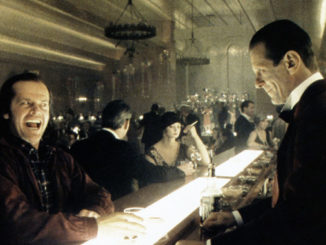
Be the first to comment